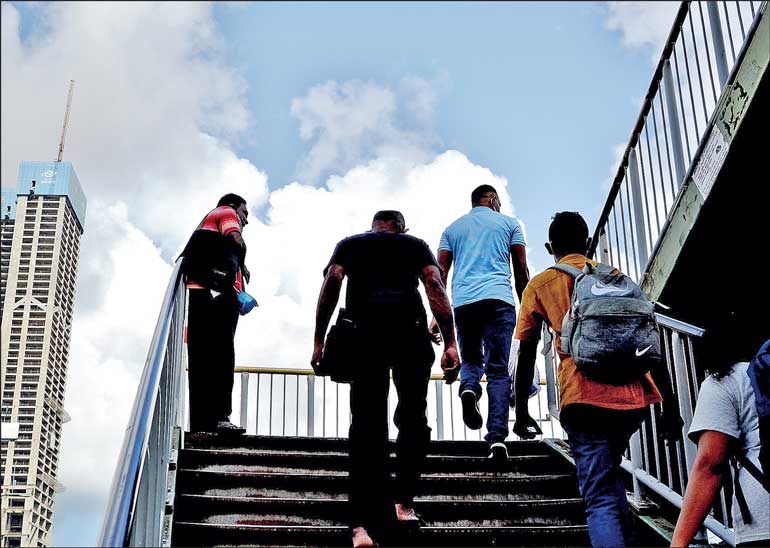Monday Apr 07, 2025
Monday Apr 07, 2025
Wednesday, 9 November 2022 00:00 - - {{hitsCtrl.values.hits}}

The shifts in the global economy mean that a concrete yet comprehensive employment recovery strategy is needed that addresses not only the short-term challenges but also the long-term opportunities for the country to pursue a job-rich and inclusive development path – Pic by Shehan Gunasekara
|
 Over 2020 and 2021, the COVID-19 pandemic created an unprecedented economic and labour market crisis around the world, mostly as a consequence of the lockdown and other containment measures used to stem the spread of the virus. ILO estimates that global working hours declined by 8.8% in 2020, equivalent to 255 million full-time jobs, while employment losses reached 114 million in that year. Certain groups and sectors, such as women, youth and micro, small and medium enterprises (MSMEs), were hit much harder.
Over 2020 and 2021, the COVID-19 pandemic created an unprecedented economic and labour market crisis around the world, mostly as a consequence of the lockdown and other containment measures used to stem the spread of the virus. ILO estimates that global working hours declined by 8.8% in 2020, equivalent to 255 million full-time jobs, while employment losses reached 114 million in that year. Certain groups and sectors, such as women, youth and micro, small and medium enterprises (MSMEs), were hit much harder.
Globally, as countries lifted lockdown measures over 2021, labour markets started recovering; in the case of advanced economies, the recovery proved to be robust, resulting in falling unemployment rates and rising employment levels. However, in most developing countries, deficits have persisted well into 2022, even before the Ukraine conflict which has subsequently precipitated a cost-of-living crisis. The global economy is now in a very fragile situation with the latest GDP projections indicating a significant slowdown in 2023 (and increasing risk of a global recession).
Consequently, countries around the world are facing multiple and overlapping crises, from the deficits and scarring created by the COVID-19 crisis to the impact of high inflation on purchasing power of workers and their families. Due to rising interest rates and high debt levels, policy space is also much tighter than two years back for most developing countries, making it more difficult and complex to respond.
As witnessed in other countries, Sri Lanka’s economy also suffered during the COVID-19 crisis, but this came on top of longer-term macroeconomic imbalances and structural challenges that had built up over decades, which left the country much more vulnerable to both the COVID-19 and the Ukraine crises. Following the shock and further disruptions emanating from the Ukraine conflict, the country slipped into a full-blown balance of payment and debt crisis in 2022, resulting in high inflation, forex shortages and restrictions on imports that are severely constraining economic activity.
|
Looking at the effects of the COVID-19 lockdowns on the Sri Lankan labour market, employment fell in 2020 (based on labour force survey data) by 2.2%. However, this figure masks considerable differences by gender; in fact, employment didn’t drop for men in 2020 (growing marginally by 0.1%), while it declined substantially for women in Sri Lanka (-6.6%). As a result, the labour force participation rate for women declined to 32.0% in 2020 (and further to 31.8% in 2021). Women’s participation in the labour market was already a major deficit before the COVID-19 crisis and has now worsened significantly.
Another key challenge is the situation facing young Sri Lankans who, like young people around the world, are vulnerable to crises. For this reason, it is not surprising that the youth unemployment rate increased in 2020, especially for those aged 20 to 24 who suffered a rise in the unemployment rate from 20.3% in 2019 to 25.2% in 2020, before increasing further to 26.8% in 2021. As seen in the wake of other crises, young people tend to have poorer labour market outcomes for much longer after a major shock or downturn, reflecting scarring effects that leave them struggling even after economies have recovered.
What needs to be done? Clearly, dealing with urgency of the economic dimensions of the crisis is a key priority in terms of restructuring debt and introducing other stabilisation measures to address macroeconomic imbalances. At the same time, it is well recognised that people are experiencing substantial income losses, which need to be counteracted by further strengthening of social protection measures, including more targeted responses to support those falling into poverty.
However, beyond these macroeconomic policy measures and the support to households via social protection transfers, it is also critical that employment is placed at the centre of the reform agenda and recovery strategy in Sri Lanka, both over the short and longer term. This can be highlighted in terms of support to micro, small and medium enterprises (MSMEs) along with workers and jobseekers.
Firstly, in the short term, the ongoing economic crisis is hurting businesses, especially MSMEs, which are struggling with input shortages, reduction in demand for goods and services and higher costs of financing. Accounting for around 52% of GDP, 90% of all businesses and 45% of employment in the country, these Sri Lankan businesses need support to reduce costs of borrowing, along with measures that help them survive (though many have already gone bust). The most vulnerable are those operating in the informal sector, which accounts for around two thirds of employment.
Over the longer term, a more strategic approach is needed to propel economic transformation and diversification that is driven by an export-led strategy, backed by investments in new technologies and other measures to improve productivity. It is crucial that MSMEs are able to join such a trajectory through access to markets and their own linkages with larger companies. Interventions to support the transition to the formal economy are required through the right mix of regulations and incentives, along with access to credit, skills development and other business development services. New opportunities in emerging sectors, including green, digital and care economies, need to be identified and facilitated where possible.
|
Secondly, looking at the situation facing workers and jobseekers, measures are needed for those affected by job losses over the short term (e.g. active labour market programs such as retraining to help those impacted find new opportunities in growing sectors). Social protection is already a priority but can be strengthened to cover the working-age population (e.g. through an unemployment insurance).
Over the coming years, the recovery strategy should give emphasis to improving labour market outcomes for women, who have faced a range of barriers to participating in the labour market, including improving childcare facilities, providing better protections and enabling flexible work arrangements. Technical and vocational education and training (TVET) needs upgrading as well recognised in the country, which should provide a demand-driven approach to skilling and help young people make the transition to sectors, which offer prospects for finding decent and productive employment. Beyond skilling, an integrated approach to dealing with youth is critical.
With the world facing gloomy prospects over the coming years, Sri Lanka’s recovery from this deep crisis won’t be easy. However, the shifts in the global economy mean that a concrete yet comprehensive employment recovery strategy is needed that addresses not only the short-term challenges but also the long-term opportunities for the country to pursue a job-rich and inclusive development path.
(The writer is the Head, Employment Strategies for Inclusive Transformation Unit, ILO.)
Discover Kapruka, the leading online shopping platform in Sri Lanka, where you can conveniently send Gifts and Flowers to your loved ones for any event including Valentine ’s Day. Explore a wide range of popular Shopping Categories on Kapruka, including Toys, Groceries, Electronics, Birthday Cakes, Fruits, Chocolates, Flower Bouquets, Clothing, Watches, Lingerie, Gift Sets and Jewellery. Also if you’re interested in selling with Kapruka, Partner Central by Kapruka is the best solution to start with. Moreover, through Kapruka Global Shop, you can also enjoy the convenience of purchasing products from renowned platforms like Amazon and eBay and have them delivered to Sri Lanka.
Discover Kapruka, the leading online shopping platform in Sri Lanka, where you can conveniently send Gifts and Flowers to your loved ones for any event including Valentine ’s Day. Explore a wide range of popular Shopping Categories on Kapruka, including Toys, Groceries, Electronics, Birthday Cakes, Fruits, Chocolates, Flower Bouquets, Clothing, Watches, Lingerie, Gift Sets and Jewellery. Also if you’re interested in selling with Kapruka, Partner Central by Kapruka is the best solution to start with. Moreover, through Kapruka Global Shop, you can also enjoy the convenience of purchasing products from renowned platforms like Amazon and eBay and have them delivered to Sri Lanka.